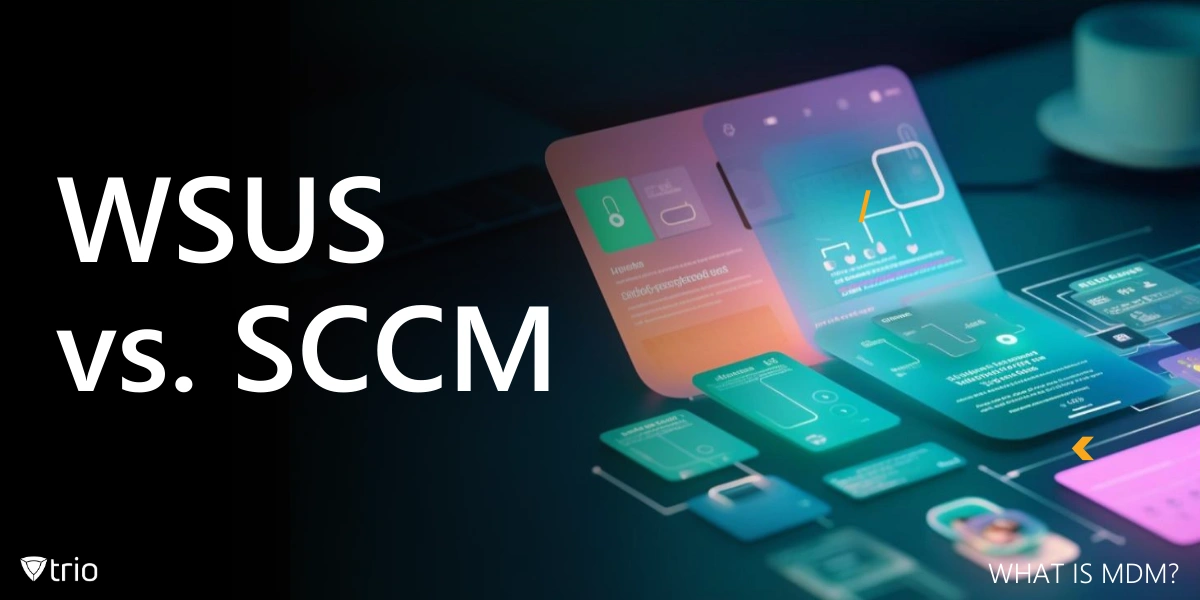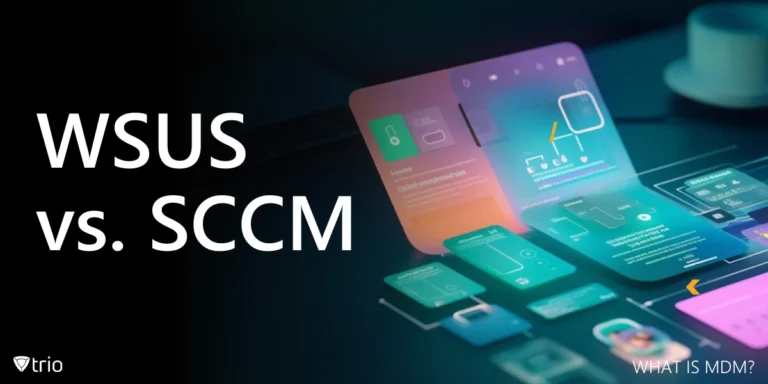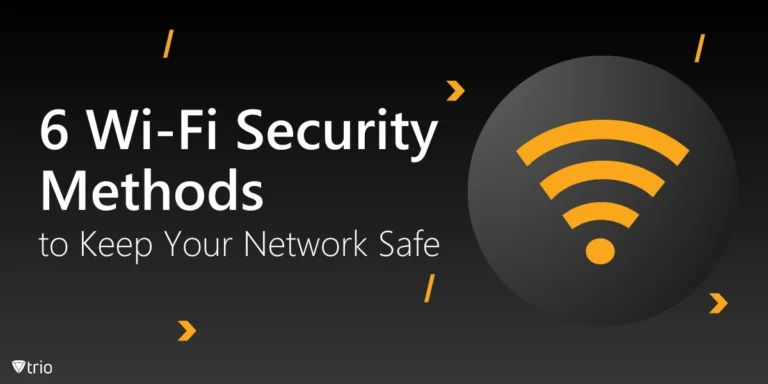Effective patch management underpins stability in today’s tech landscape. Organizations need to understand what MDM is, because controlling various devices and systems can be very tricky. Vital updates might slip through the cracks without a well-structured strategy, causing disruptions that often hamper productivity and risk exposing vulnerabilities to potential threats.
In this landscape, WSUS (Windows Server Update Services) and SCCM (System Center Configuration Manager) emerge as widely recognized solutions. They tackle updates and configurations across large or small environments. Understanding the classic battle of WSUS vs SCCM helps stakeholders navigate a range of demands that might otherwise derail operational efficiency.
Shining a spotlight on these two tools underscores their purpose in safeguarding uptime. They share a commitment to handling patches systematically, yet their approaches can vary. This post unpacks eight lesser-known revelations, offering practical angles that clarify differences and seriously highlight considerations for anyone balancing reliability with evolving organizational needs.
What Is WSUS?
WSUS focuses on delivering updates for Windows-based devices across an organization. It acts as a centralized repository, enabling administrators to approve, schedule, and distribute patches efficiently. This structure eases the chaos of scattered manual updates and consolidates control into a single point, improving consistency and reducing guesswork and overall confusion.
Centralized scheduling is a key WSUS feature, letting teams time installations so system reboots happen with minimal disruption. Administrators also appreciate the automatic detection of fresh updates and the convenience of bundling essential security fixes. This simplified arrangement streamlines patch cycles, preventing oversight that might otherwise expose systems to hazards.
Small and medium-sized organizations find WSUS appealing when dealing with strictly Windows environments. It handles daily updates and periodic patch rollouts without demanding massive server infrastructures. For teams that prize direct control yet prefer minimal overhead, WSUS answers these needs, forging a steady path for consistent protection and operational continuity.
In discussions around WSUS vs SCCM for patching, WSUS remains a straightforward contender. Organizations enjoy its built-in Microsoft integration, along with direct oversight of which machines receive updates. Though it lacks some advanced automation, it still satisfies patching basics. Many see WSUS as a trusted starting point for Windows-focused networks.

What Is SCCM?
SCCM positions itself as a broad IT management software suite that organizes updates, application installations, and device inventories. Its toolset extends beyond patching, addressing matters like endpoint security and network performance. Administrators employ SCCM to unify oversight, ensuring that critical systems run efficiently without juggling multiple scattered utilities and consoles.
Integration with the broader Microsoft ecosystem highlights SCCM’s seamless fit alongside Active Directory and Exchange. When considering Windows Intune vs SCCM, SCCM’s local infrastructure excels at granular policy enforcement, though it demands extra setup. Organizations gain broad unity, with advanced reporting that cuts through complexities and fosters much better insights.
Larger companies with diverse fleets often embrace SCCM to coordinate updates across thousands of endpoints. Hybrid setups, featuring both on-premises and cloud environments, also benefit from SCCM’s wide-ranging capabilities. This tool shines wherever organizations demand extensive configuration control, offering adaptability across various device types that frequently coexist under one umbrella.
Sophisticated automation sets SCCM apart from simpler solutions. Administrators schedule customized deployments, gather granular data, and tackle vulnerabilities in a unified way. While complexity can intimidate novices, the payoff comes through streamlined oversight and deeper metrics. SCCM embodies a strategic choice for growth-minded organizations seeking progressive lifecycle management at scale.
8 Surprising Insights: WSUS vs. SCCM
Examining WSUS and SCCM side by side reveals contrasts that shape decision-making. While both manage updates, they diverge in architecture, feature breadth, and operational scope. These eight revelations offer clarity, guiding professionals who weigh easy patch rollouts against advanced oversight. The final verdict often hinges on unique goals and contexts.
1. Architecture and Scalability
WSUS relies on a single server approach that fits smaller networks well, though it faces hurdles when scaling to huge infrastructures. SCCM embraces distributed components designed for broader deployments, simplifying growth. Balancing initial simplicity against future expansion becomes vital when deciding which route protects stability across multiplying endpoints and locations.
2. Feature Range and Integration
SCCM stands out with broad configuration management capabilities, orchestrating software distribution, compliance settings, and patch schedules under one umbrella. WSUS focuses on updates alone, offering fewer bells and whistles yet remaining easier to configure. This difference often tips the scales for teams seeking a fuller, broader suite of management functionality.
3. Automation and Customization
Some organizations value deep asset management alongside patching, which SCCM handles through robust automation. WSUS takes a simpler route, typically requiring manual approvals and fewer scripting options. SCCM’s customizable workflows empower administrators to tailor update schedules, integrate third-party tools, and push specialized configurations that streamline maintenance without constant human intervention.
4. Costs and Licensing
Licensing draws a clear line between WSUS and SCCM. WSUS is included with Windows Server, presenting an attractive baseline for budget-conscious teams. SCCM, however, operates under a separate licensing model that covers extensive functionality. The investment can pay off for those chasing integrated oversight, but cost planning remains a factor.
5. Reporting and Analytics
WSUS includes basic reports detailing update statuses, yet customization options stay limited. SCCM ramps up visibility with dashboards offering granular data on patch success rates, software usage, and ongoing compliance trends. These insights help managers make timely decisions, bolster accountability, and track progress across departments aiming for stable, secure operations.
6. Security and Compliance
Both WSUS and SCCM support security patching, yet SCCM’s advanced rule sets expedite threat response. Its compliance features flag machines that miss critical updates, helping organizations stay audit-ready. WSUS addresses security demands too, yet its limited scope can leave gaps, prompting some to seek a heftier platform for tight oversight.
7. Handling Third-Party Updates
WSUS primarily manages Microsoft patches, so third-party updates require manual setups or specialized extensions. SCCM, on the other hand, accommodates wider vendor support, allowing consolidated distribution of fixes. This holistic approach appeals to teams that juggle applications across multiple brands, streamlining patch workflows without requiring separate processes for each product.
8. Suitability for Different Organization Sizes
Smaller outfits often find WSUS sufficient, especially if they operate within a single domain and prefer minimal complexity. Larger enterprises turn to SCCM when they crave expansive integration and automated oversight for numerous devices. Identifying organizational goals remains the deciding factor, revealing which tool excels at balancing coverage and manageability.
Common Deployment Scenarios
Single-server setups favor WSUS, which handles patch coordination in a direct manner. Distributed environments, however, benefit from SCCM’s layered infrastructure, particularly when cross-department synchronization matters. Some teams experiment with phased rollouts, verifying stability on a small scale before broadening updates. Each approach aims to avert disruptions and maintain security coverage.
Bulk deployment scenarios highlight SCCM’s power, especially for organizations juggling massive numbers of devices spread over different locations. WSUS can still thrive if the hardware stack remains homogenous and administrators appreciate hands-on approvals. The choice often hinges on whether advanced automation holds priority over straightforward patching for uniform Windows endpoints.
Key takeaways revolve around understanding scale, architecture, and future goals. Some situations demand a bare-bones patch solution, while others require sweeping oversight with granular controls. Evaluating existing infrastructure is essential, as well as anticipating upcoming growth. The solution that matches these factors becomes the pivotal piece in ensuring seamless operations.
Future Outlook & Evolving Needs
Patch management evolves rapidly, reacting to persistent security threats and a growing patch frequency. Many organizations eye-integrated ecosystems that unify endpoints under a single pane of glass. Automation and policy enforcement are becoming standard, with solutions refining analytics and real-time threat detection to meet the rising tide of vulnerabilities.
Cloud-based MDM solutions have also transformed how patches are delivered, offering remote oversight and zero-touch rollouts. Organizations increasingly prioritize Mobile Device Management Implementation strategies that stretch beyond traditional desktops, aiming to reduce IT costs through unified approaches. These methods streamline governance, sidestepping disjointed systems that complicate policy enforcement and chaos.
Looking ahead, integration across platforms will likely intensify as enterprises incorporate remote work policies and bring-your-own-device trends. Unified dashboards and automated workflows could become standard, fostering immediate vulnerability fixes. This shift may benefit teams seeking sophisticated patch orchestration, setting the stage for simpler, safer, and highly resilient operational ecosystems globally.

Trio: Your MDM Ally
MDM extends beyond smartphones, encompassing tablets, laptops, and specialized rugged devices. Trio embraces this expansive view, delivering centralized command over diverse hardware within modern workplaces. By aligning patch management with real-time monitoring, it empowers teams to maintain healthy endpoints. Trio’s approach addresses change, providing a versatile blueprint for controlled updates.
For a deeper taste of Trio’s capabilities, try the free demo and see how consolidated dashboards truly simplify day-to-day tasks. This platform coordinates updates while unifying device policies to bolster security and consistency. By bridging patch management with holistic MDM, Trio positions itself as a key partner for growing teams.
Conclusion
WSUS and SCCM serve unique roles in the update management sphere. WSUS presents a streamlined entry point for Windows-driven environments, while SCCM embodies a multifaceted suite addressing greater organizational complexity. Each method underscores reliability and security through patching, yet their differences emerge in scale, automation, and additional core management features.
See Trio in Action: Get Your Free Trial Now!
Choosing between these two hinges on weighing present infrastructure against future ambitions. Smaller teams might gravitate toward WSUS, enjoying simpler administration, whereas bigger entities often pick SCCM for its orchestration depth. Neither option holds universal supremacy. The right fit arises when leadership aligns organizational goals with each tool’s distinct strengths.
In a digital landscape where continuous patching protects data and uptime, WSUS and SCCM remain valuable choices. Anyone charting this terrain should assess capabilities, weigh expansion needs, and consider synergy with broader strategies. By embracing thoughtful planning, organizations can dodge pitfalls, sustain compliance, and maintain dependable systems for daily demands.




